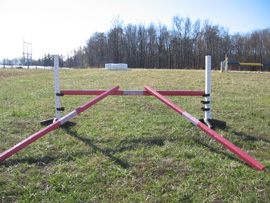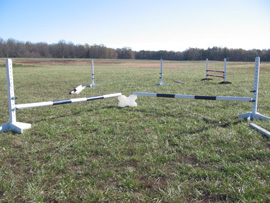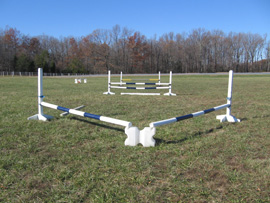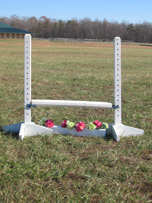As a jumping rider, one of your primary jobs is to pick the line and channel your horse onto that line. With a green horse, be sure he has adequate time to make the turn, bring his shoulders around on the straight line, and comprehend what he is being asked to do. Be ready to make small adjustments with the rein and/or leg to correct small shifts off the line. If you have a horse who approaches straight, but who drifts in the take-off, jump or landing, guide rails may help straighten him without requiring a change in the rider’s aids. See picture below.



Start jumping through the chute and over the block (left picture). This is far easier than the next exercise, in which you jump the point into the chute (right picture).
Let the Horse Look, Sniff, Lick & Eat!
With a green horse, there is no reason to expect they would jump over something they have not had the opportunity to check out. Before presenting any new obstacle to be jumped, walk your horse up along the side of it (do not walk them straight at it, because you do not want them to think you are asking them to jump it – especially if it has any significant height). Let them turn their head to look, sniff, lick or eat until they couldn’t be more bored (this will usually take less than a minute). Eventually you will be able to phase out this technique as your horse gets more jumping experience and begins to identify new jumps as being similar to old jumps. This process can take a year or more, so don’t be in a rush. Your horse will tell you when he no longer needs a good look and lick!
When in doubt, take it slow
Anytime you approach something new with your green horse, give him time to look and think. If you or your horse have any doubts, down shift within gait or to a slower gait if you can safely do so. If you can safely walk the obstacle (especially applicable for water, ditches and banks), then give your horse as long of a rein as possible, and let him walk. When introducing cantering cross country jumps, many horses will break into the trot in the last 5 or 6 strides – don’t chase them! Most run-outs in these circumstances happen because the rider panics that their horse has broken into the trot, and they flap around in the saddle trying to thrust the horse back into a canter. Before they know what happened, the horse has slipped right past the jump. Instead, sit quietly and let your horse figure out the task – most horses can safely trot much bigger jumps than you might think (and, remember, we’re introducing new obstacles at small heights so you can feel perfectly safe in trotting). As you reach the jump, be ready with a supporting leg if he needs a little extra encouragement, and be ready to grab mane and/or slip the reins if they make a big jump. Then, after the horse has figured out the question, come back around at the canter and be very supportive with your leg as you approach to indicate that cantering the entire approach is the objective.
Don’t ask the horse to do anything he can’t do in the dressage arena
One day, as I was trying to adjust my young horse’s stride in the approach to a jump so he would take off on a good stride, Jim Wofford asked me “Can you lengthen and shorten this horse’s canter stride in the dressage arena?” With a chuckle, I said “yea, right – NO!” And Jim replied, “then why on earth would you try to adjust the length of his stride when there’s a jump in front of you.” Oh, right, point taken.Think of your jumping work as an extension of dressage work with jumps thrown in the way. Only ask your horse to perform the movements that he has the balance and impulsion to perform correctly on the flat. Do not ask him to do 10 meter circles, lengthenings or leg yields in the approach to a jump if he is not competent at them in the dressage arena.
Never give up and go home.
One of the worst lessons a horse can learn is that if he says “no” then he gets to go home. With a young/green horse, be entirely certain both you and the horse are capable of jumping everything you present to him. Once you have committed to jumping something, be prepared to stay there until you get the job done. When jumping without your trainer, be aware of your own personal limitations in being able to get your horse to jump something he does not like. Your trainer should have a set of tricks that may be helpful, which can sometimes be difficult to replicate without a ground person or another more experienced horse. For example, allowing a green horse to follow close behind a brave lead horse will show them that the jump can in fact be conquered. With or without your trainer, you must always find a way to give your green horse a confidence building experience which never ends in giving up.
Be aware of the questions you are asking of your horse and don’t increase too many questions at once. A good rule of thumb is to only change one question at a time, and simultaneously reduce the difficultly of the previous questions if possible. A good ground person is critical to allow you to build questions slowly. With a green horse, before a new jump is added to a gymnastics line, a ground pole should be set in its place first. Also, if you have been jumping a 3’ gymnastics line, when you add an additional jump, reduce the height of the line to 2’9” or 2’6”. Or, if you are introducing a combination of jumps on a hill, jump a single jump up the hill and then down the hill. Then go back to jumping up hill (which is easier) when you add the next jump into the combination. Never feel like you have to tackle an entire combination at once – there will be plenty of time for that before you make it to the Badminton Four Star! And never be afraid to ask your trainer if you can break an exercise into parts, before you put it all together. Remember, your confidence is just as important as your horse’s confidence!
Gymnastics. Gymnastics. Gymnastics.
With a young/green horse, you can never go wrong with gymnastics jumping. Just remember the physical demands of increasingly longer gymnastics lines, so be careful of overdoing it. Dressage ‘S’ judge, Elizabeth Madlener, explains that it could take weeks or months for the average person to have the physical ability to do the splits. It takes a lot of flexibility and strength to ask your horse to bring his hindquarters far under himself and then push-off with a rounded back. So, keep it small and don’t do too much in a single day. He will develop the strength to look like a ballet dancer leaping gracefully through a gymnastics line, but don’t be surprised if it takes months to achieve.
Get Technical Early – Keep it Small
Once you are convinced that your horse has developed a solid confidence over basic jumping questions, drop the fences down to about 12 inches and start getting technical. Lucinda Green explains how ridiculous it is for riders to expect a horse to successfully jump his first corner when he sees it on a Preliminary cross country course at 3’6” tall! Why not let him learn the concept when the jump is 12 inches tall? Make sure the vertices of the corner have enough angle to make it a true corner, but don’t make it a question of height. Make it a question of straightness and directional control (i.e., can you steer your horse to jump within one foot of the point of the point?). Another idea is to introduce very skinny (4 foot wide rails) as ground poles, then as 6 inch high jumps. Work up from there. When you’re ready have some fun throwing corners and skinnies into wavy lines, serpentines and odd distances, while keeping the height teeny-tiny. See pictures below of a miniature-height corner jump and skinny.


Praise. Praise. Praise.
Focus on what your horse does right. As he learns, he will make mistakes. Handle blatant disobediences as such, but if he makes a mistake, don’t make it a big deal. It’s not okay, but it’s not horrible either – so, just go-on and do it again. When he does it right, make a huge deal over him. It is extremely important to start praising as soon as your horse does something right. If he jumps well, say “good boy” in the air and pat him immediately – if you wait until you pull-up to praise him, then you have essentially rewarded him for stopping, not for jumping.
Straight Line – Whoe!
If you go to a Lucinda Green clinic, you will probably hear her holler “straight line – whoe!” at least 100 times in the day. If you go to a Philip Dutton clinic, you will probably hear him send countless riders back off to finish the jumping line with a balanced canter on the correct lead. Jim Wofford will tell you he could cheer with you all day long about how lovely your last jump was, but you have another one to jump – and David O’Connor almost learned that lesson the hard way in the Olympics when he almost turned the wrong way on the show jumping course! These stories may appear to have nothing in common, but they all share one fundamental concept - teach your horse to always ask “what’s next” after he completes a jump. Especially with green horses, sometimes we get so excited they have jumped well, everything falls apart afterwards! Depending on the needs of your horse, pick a technique or rotate between a few, but always remember to instill upon your horse that he should always assume there is more to be done, until you ask him to stop.
The bottom line is that it’s the horse’s responsibility to do the jumping. However, it’s the rider’s job to get the horse to the jump and to steer him between a shoot created by the rider’s hands and legs. This is one of the hardest jobs for a beginner rider, and often they feel victim to a last moment run-out, when their trainer saw it coming 10 strides out! Recognizing just how difficult this may be, I’m still going to say it - Never let your horse run past a jump. If you feel a run-out coming, engage every part of your body to keep your horse in front of the jump. If he stops, that’s okay, keep him in front of the jump. Because, we were smart & the jump is small enough that your horse can easily walk over it. Now he has learned a positive lesson that running out is not an option, and the obstacle can be negotiated. Now you should be able to return to a trot or canter and have no further problems at this jump. If running out is never introduced into your horse’s repertoire, there is far less of a chance that it will be a problem when you start jumping larger fences for which the above technique could not be safely applied.
Created by Cherie Chauvin
Golightly Sport Horses
www.golightlysporthorses.com
703-801-7982